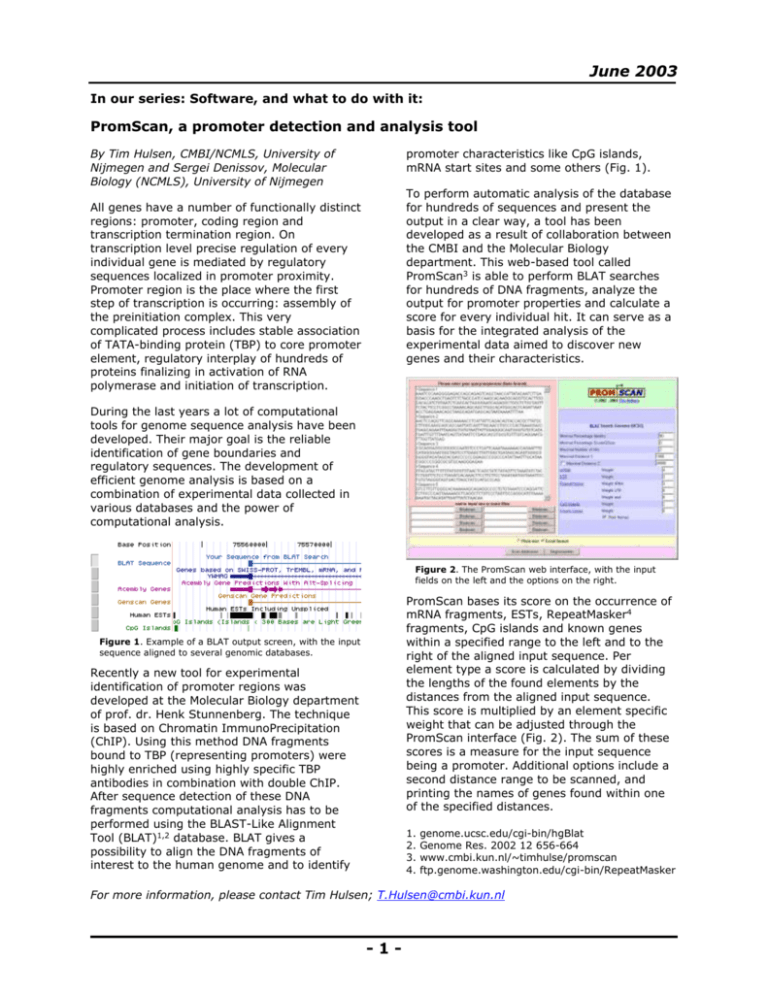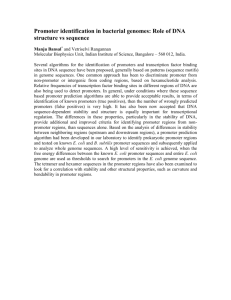In this issue
advertisement

June 2003 In our series: Software, and what to do with it: PromScan, a promoter detection and analysis tool By Tim Hulsen, CMBI/NCMLS, University of Nijmegen and Sergei Denissov, Molecular Biology (NCMLS), University of Nijmegen promoter characteristics like CpG islands, mRNA start sites and some others (Fig. 1). To perform automatic analysis of the database for hundreds of sequences and present the output in a clear way, a tool has been developed as a result of collaboration between the CMBI and the Molecular Biology department. This web-based tool called PromScan3 is able to perform BLAT searches for hundreds of DNA fragments, analyze the output for promoter properties and calculate a score for every individual hit. It can serve as a basis for the integrated analysis of the experimental data aimed to discover new genes and their characteristics. All genes have a number of functionally distinct regions: promoter, coding region and transcription termination region. On transcription level precise regulation of every individual gene is mediated by regulatory sequences localized in promoter proximity. Promoter region is the place where the first step of transcription is occurring: assembly of the preinitiation complex. This very complicated process includes stable association of TATA-binding protein (TBP) to core promoter element, regulatory interplay of hundreds of proteins finalizing in activation of RNA polymerase and initiation of transcription. During the last years a lot of computational tools for genome sequence analysis have been developed. Their major goal is the reliable identification of gene boundaries and regulatory sequences. The development of efficient genome analysis is based on a combination of experimental data collected in various databases and the power of computational analysis. Figure 2. The PromScan web interface, with the input fields on the left and the options on the right. PromScan bases its score on the occurrence of mRNA fragments, ESTs, RepeatMasker4 fragments, CpG islands and known genes within a specified range to the left and to the right of the aligned input sequence. Per element type a score is calculated by dividing the lengths of the found elements by the distances from the aligned input sequence. This score is multiplied by an element specific weight that can be adjusted through the PromScan interface (Fig. 2). The sum of these scores is a measure for the input sequence being a promoter. Additional options include a second distance range to be scanned, and printing the names of genes found within one of the specified distances. Figure 1. Example of a BLAT output screen, with the input sequence aligned to several genomic databases. Recently a new tool for experimental identification of promoter regions was developed at the Molecular Biology department of prof. dr. Henk Stunnenberg. The technique is based on Chromatin ImmunoPrecipitation (ChIP). Using this method DNA fragments bound to TBP (representing promoters) were highly enriched using highly specific TBP antibodies in combination with double ChIP. After sequence detection of these DNA fragments computational analysis has to be performed using the BLAST-Like Alignment Tool (BLAT)1,2 database. BLAT gives a possibility to align the DNA fragments of interest to the human genome and to identify 1. 2. 3. 4. genome.ucsc.edu/cgi-bin/hgBlat Genome Res. 2002 12 656-664 www.cmbi.kun.nl/~timhulse/promscan ftp.genome.washington.edu/cgi-bin/RepeatMasker For more information, please contact Tim Hulsen; T.Hulsen@cmbi.kun.nl -1-









